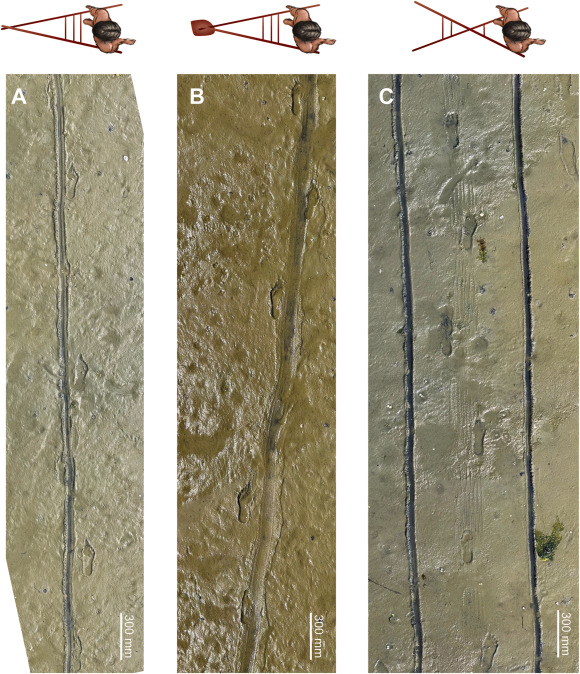Track marks in the desert at White Sands, New Mexico, are thought to have been made by a simple ancient hand cart. Given the age of the layer in which the tracks are found, these tracks represent by far the oldest evidence known for this method of transporting goods, long before the wheel was added.
ADVERTISEMENT
Until 2021, White Sands, New Mexico was best known as the site for the first atom bomb test, but now it has a more attractive claim to fame. Footprints found in the White Sands National Park in 2009 were dated 12 years later as being 21,000-23,000 years old, based on radiocarbon dating of seeds in the same layers. The shape of the prints indicates humans were in the Americas at the peak of the last Ice Age, instead of arriving as it finished as had been widely believed not long beforehand. Other discoveries pushed back human arrival in the Americas, but White Sands appears to be the earliest reliable example.
Naturally palaeontologists have pored over the more than 60 footprints found at White Sands, but a new study investigates drag marks that accompany them. The authors say these represent traces left by wooden poles they think were dragged behind a walker, sometimes partially erasing footprints made by the individual dragging the object.
The authors built simple wooden carts known as travois, for example by making an A-frame with an extra crossbar or two. They dragged them across mudflats in Dorset, UK and Maine, holding the ends of the poles while the apex dragged in the mud, and comparing the results with those at White Sands.
Some of the White Sands tracks, known as Type I, match those made by this design, but Type II are broader and shallower, suggesting something was used to spread the point of impact. A cloth bag achieves a similar effect. Type III tracks run in parallel, and could be made by reversing the travois’ orientation so the ends of the poles dragged behind.

Type I, II and III tracks with the type of travois that might have made them.
In The Conversation some of the authors write, “The research team has benefited from the insight of the Indigenous peoples we work with at White Sands, and they interpret the marks in this way as well.”
Travois were used by Indigenous peoples when Europeans first arrived in the Americas, but there has previously been no indication of how ancient they are. With rare exceptions, wooden tools rot easily. Many accounts of travois, both from community memories and European accounts, refer to them being pulled by horses, making it hard to rule out the possibility they were first built only when pulling them could be outsourced to animals.
ADVERTISEMENT
On the other hand, it is likely that people traveling through snowfields, as early North Americans almost certainly did, would have learned the benefits of sleds, and these may have inspired ideas for other means of transport.
“We think the travois were probably improvised from tent poles, firewood and spears when the need arose,” the authors say. Any assistance in transportation would have been useful when moving camp, but the authors think the most likely application was in dragging meat home after a large kill.
The many children’s footprints White Sands indicate they trailed behind those who were pulling the cart. The authors consider the alternative possibility the tracks were made by dragging firewood, but conclude this can only account for Type I tracks. Some of the Type II could have been made by boats such as kayaks, but the authors consider their locations make this unlikely.

Dragging firewood could have accounted for some of the tracks, but not for others.
The White Sands dating has been called into question, but the authors argue that even if it is wrong, certain animal prints on the same strata level prove the tracks preceded the Holocene.
ADVERTISEMENT
The first invention of the wheel is still much debated, but a recent study places the origins almost 6,000 years ago in the Carpathian Mountains. The more widespread hand carts were, the easier it would have been to make the cognitive steps needed to invent this world-changing idea. So far we have no evidence of Eurasian travois old enough to have planted the seed.
The study is published open access in Quaternary Science Advances.
Source Link: Tracks Hint Native Americans Had Handcarts 16,000 Years Before The Wheel